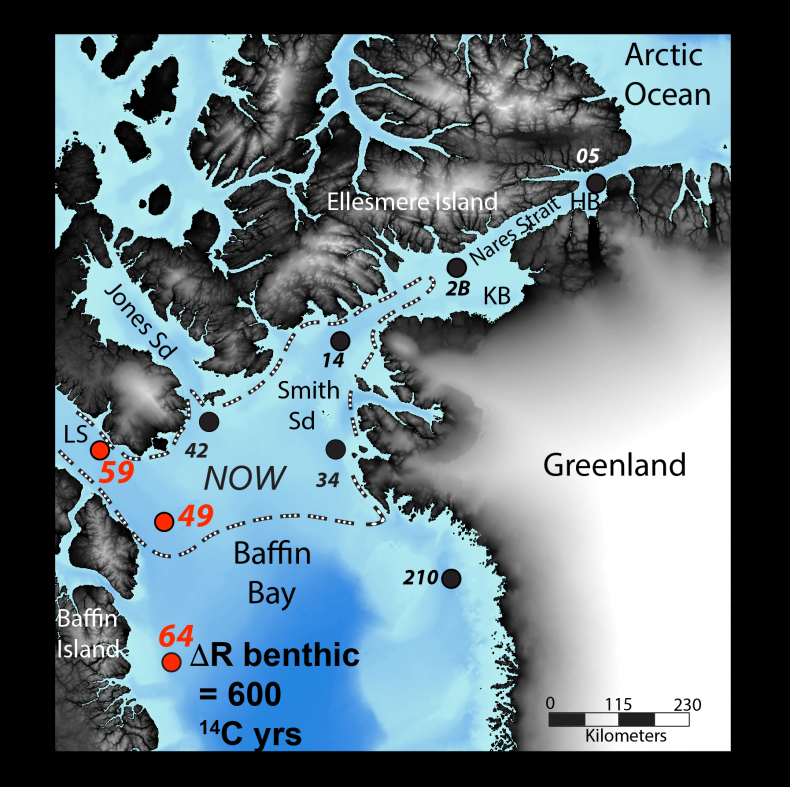The author(s) will give a talk
Foraminiferal stratigraphy and lithofacies reveal the timing and environments of deglaciation and onset of Arctic/Atlantic throughflow in the Arctic Island Channels
1 INSTAAR
2 INSTAAR
3 INSTAAR
4 CU Boulder
5 INSTAAR
6 CU Boulder
7 CU Boulder
8
The Arctic Island Channels (AIC) usher low-salinity, nutrient-rich Arctic surface water (ASW) and sea ice into the North Atlantic with consequences for the Atlantic Meridional Overturning Circulation (AMOC). The largest of these channels are Nares Strait and Parry Channel (Figure 1). The channels were blocked to Arctic/Atlantic throughflow by confluent ice sheets until the early Holocene. However, the timing of opening of the channels is poorly constrained as is the ensuing development of the North Water polynya that occupies northern Baffin Bay today, with productivity fueled by nutrient rich ASW. Sediment cores from Lancaster Sound, at the southeastern end of Parry Channel, capture sediment sequences that record retreat of confluent Innuitian and Laurentide ice-sheets through to modern marine conditions. We present data from three sites: 2008029-59CC (composite trigger core and piston core), inside Lancaster Sound; 2008029-49CC (composite box core, trigger core and piston core) at the mouth of Lancaster Sound and 2013029-64PC off Buchan Trough on the northern Baffin Island slope (Figure 1). Analyses of lithofacies, including counts of >2mm clasts (ice-rafted detritus (IRD)), biogenic silica, sediment mineralogy and foraminiferal assemblage data from these cores provide insight into the changing environmental conditions during deglaciation and establishment of the Arctic/Atlantic throughflows. Radiocarbon dates on foraminifera and marine algae macrofossils constrain the timing of events. A pair of 14C dates on benthic and planktic foraminifers from the same sample in 64PC (875 m water depth) provides a local marine reservoir correction ΔR= 600 years to calibrate early Holocene dates on calcareous benthic organisms in the deep shelf trough sites of our cores (>580 m). Three additional benthic/planktic paired dates from the Lancaster Sound cores have been submitted to further define the early Holocene marine reservoir age.
In Lancaster Sound, glaciomarine conditions as defined by pebbly mud lithofacies overlying till begin by 11.1 cal ka BP and end at about 10.5 cal ka BP based on lack of IRD. The overlying mud unit with pyritized burrows and highly abundant calcareous benthic and planktic foraminifers and increased biogenic silica suggests that Lancaster Sound may have been open to the Arctic Ocean by 10.5 cal ka BP. An agglutinated faunal zone with >80% agglutinated foraminifers coincides with a change to increased bioturbation and lower sedimentation rates. This zone begins soon after 8.7 cal ka BP, similar in timing to the opening of Nares Strait to ASW throughflow.
There are three foraminiferal zones defined by cluster analysis in each of the 3 cores. The zones are similar in faunal characteristics and timing. The deepest zone occurs in the detrital carbonate rich pebbly mud units overlying the till. It comprises low abundance, benthic foraminiferal faunas dominated by glaciomarine species and Stainforthia feylingi, reflecting glacial meltwater input and sea-ice cover while glacier ice was grounded in Lancaster Sound. Faunal zone 2 is characterized by high abundance of calcareous benthic fauna reflecting marine productivity with dominant Islandiella norcrossi and increasing planktic foram abundance. The opening of Parry Channel occurs in this zone coinciding with the end of IRD-rich sediment and deposition of bioturbated mud. It is marked by an abrupt increase in planktic foraminifera c. 10.5 cal ka BP in all three cores. Faunal zone 2 marks establishment of a regional marine optimum with reduced summer sea ice and increased flux of nutrient rich Arctic Surface Water fueling marine productivity. Faunal zone 3 is defined by >80% agglutinated foraminifers and greatly decreased foraminiferal abundance. It coincides with increased bioturbation, increased biogenic silica and presumed lower sedimentation rates. This zone begins soon after 8.7 cal ka BP based on 14C dates on seaweed macrofossils in all 3 cores and is similar in timing to the opening of Nares Strait to ASW throughflow. The low abundance of foraminifera likely is due to carbonate dissolution related to undersaturation of calcite by increased inflow of Arctic Surface Water, diminished input of detrital carbonate and increased biogenic carbon flux as reflected by bioturbation and the high diatom abundance.

Fig 1.
Map of study area in northern Baffin Bay showing locations of cores in this study (red dots) 2008029-59, 2008029-49 and 2013029-64 taken by the Geological Survey of Canada. The North Water Polyna (NOW) typical extent in June is shown by hatched line. LS = Lancaster Sound, KB = Kane Basin, HB = Hall Basin. Black dots are other cores in this project.
This research is funded by National Science Foundation OPP-1804504. We acknowledge the contributions by Robbie Bennett and Kimberley Jenner of the GSC and Benoit Lecavalier of Memorial University.